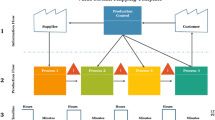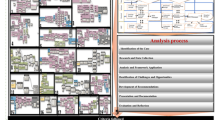Abstract
Industrial construction management increasingly needs to integrate processes, technologies, and people to support strategic objectives and seeks to eliminate waste to achieve more efficient results. From this, the synergistic use of building information modeling (BIM) and lean construction (LC) principles can bring continuous improvements to the construction industry. This paper proposes a novel methodology for interdisciplinary management of construction projects by integrating BIM into LC. First, the study presents a literature review of BIM and lean methods and tools. Afterward, the research proposes the Digital Obeya Room framework for visual management of industrial pipelines manufacturing. A real-world application evaluates this new proposal on production planning and control of an industrial construction. From this experiment, the study presents results from a focus group that correlates the applied BIM functionalities and lean principles with the PDCA stages of industrial construction. This paper contributes to planning predictability, integration among stakeholders and usage of lean and BIM for continuous improvement of engineering management.




Similar content being viewed by others
References
Sacks R, Radosavljevic M, Barak R (2010) Requirements for building information modeling based lean production management systems for construction. Autom Constr 19(5):641–655
Wang X, Love PED, Kim MJ, Park C-S, Sing C-P, Hou L (2013) A conceptual framework for integrating building information modeling with augmented reality. Autom Constr 34:37–44
Dave B, Kubler S, Pikas E, Holmström J, Singh V, Främling K, Koskela L et al (2015) Intelligent products: shifting the production control logic in construction (with lean and BIM). In: Proceedings of the 23rd annual conference of the international group for lean construction, Perth, 29–31 July 2015. International Group for Lean Construction
Almarshad A, Motawa I (2012) BIM-based knowledge management for building maintenance. In: Proceedings of the 29th International Conference of CIB W78, Beirut, Lebanon, pp 17–19
Hattab MA, Hamzeh F (2015) Using social network theory and simulation to compare traditional versus BIM–lean practice for design error management. Autom Constr 52:59–69
Oskouie P, Gerber DJ, Alves T, Becerik-Gerber B (2012) Extending the interaction of building information modeling and lean construction. In: Proceedings for the 20th annual conference of the international group for lean construction, pp 1–617
Jung Y, Joo M (2011) Building information modelling (BIM) framework for practical implementation. Autom Constr 20(2):126–133 (building information modeling and changing construction practices)
Barlish K, Sullivan K (2012) How to measure the benefits of BIM—a case study approach. Autom Constr 24:149–159
Saieg P, Sotelino ED, Nascimento D, Caiado R (2018) Interactions of building information modeling, lean and sustainability on the architectural, engineering and construction industry: a systematic review. J Clean Prod 174:788–806
Nascimento DLM, Sotelino ED, Lara TPS, Caiado RGG, Ivson P (2017) Constructability in industrial plants construction: a BIM–lean approach using the Digital Obeya Room framework. J Civil Eng Manag 23(8):1100–1108
Ivson P, Nascimento D, Celes W, Barbosa SD (2017) Cascade: a novel 4D visualization system for virtual construction planning. IEEE Trans Vis Comput Graph 24(1):687–697
Papadopoulos NA, Sotelino ED, Martha LF, Nascimento DLM, Faria PS (2017) Evaluation of integration between a BIM platform and a tool for structural analysis. Sist Gestão 12(1):108–116
Pilehchian Behzad, Staub-French Sheryl, Nepal Madhav Prasad (2015) A conceptual approach to track design changes within a multi-disciplinary building information modeling environment. Can J Civil Eng 42(2):139–152
Womack JP, Jones DT (2010) Lean thinking: banish waste and create wealth in your corporation. Simon and Schuster, New York
Comm CL, Mathaisel DFX (2005) A case study in applying lean sustainability concepts to universities. Int J Sustain Higher Educ 6(2):134–146
NIST GCR (2004) Cost analysis of inadequate interoperability in the US capital facilities industry. National Institute of Standards and Technology (NIST), Gaithersburg
Arayici Y, Coates P, Koskela L, Kagioglou M, Usher C, O’reilly K (2011) Technology adoption in the BIM implementation for lean architectural practice. Autom Constr 20(2):189–195
Eastman CM, Eastman C, Teicholz P, Sacks R (2011) BIM handbook: a guide to building information modeling for owners, managers, designers, engineers and contractors. Wiley, New York
Bryde David, Broquetas Martí, Volm Jürgen Marc (2013) The project benefits of building information modelling (BIM). Int J Project Manag 31(7):971–980
de Mattos Nascimento DL, Sotelino ED, Caiado RGG, Faria PS et al (2017) Synergy between principles of lean thinking and BIM functionalities in interdisciplinarity of management in industrial plants. J Lean Syst 2(4):84–109
Aziz RF, Hafez SM (2013) Applying lean thinking in construction and performance improvement. Alex Eng J 52(4):679–695
Olatunji OA (2011) Modelling the costs of corporate implementation of building information modelling. J Financ Manag Property Constr 16(3):211–231
Oosterwal DP (2010) The lean machine: how Harley–Davidson drove top-line growth and profitability with revolutionary lean product development. AMACOM Division American Management Association, New York
Tortorella G, Viana S, Fettermann D (2015) Learning cycles and focus groups: a complementary approach to the A3 thinking methodology. Learn Organ 22(4):229–240 (cited by 2)
Koskela Lauri (1992) Application of the new production philosophy to construction, vol 72. Stanford University, Stanford
Voss Chris, Tsikriktsis Nikos, Frohlich Mark (2002) Case research in operations management. Int J Oper Prod Manag 22(2):195–219
Yin RK (2015) Estudo de Caso: Planejamento e Métodos. Bookman Editora, Madrid
Runeson P, Höst M (2009) Guidelines for conducting and reporting case study research in software engineering. Empir Softw Eng 14(2):131–164
Dürrenberger G, Behringer J, Dahinden U, Gerger A, Kasemir B, Querol C, Schüle R, Tabara D, Toth F, van Asselt M et al (1997) Focus groups in integrated assessment: a manual for a participatory tool. Center for Interdisciplinary Studies in Technology, Darmstadt University of Technology, Darmstadt
Morgan JM, Liker JK (2006) The Toyota product development system, vol 13533. Productivity Press, New York
Shahbazi S, Javadi S (2013) Supporting production system development through Obeya concept
Azhar S, Nadeem A, Mok JY, Leung BH (2008) Building information modeling (BIM): a new paradigm for visual interactive modeling and simulation for construction projects. In: Proceedings of the first international conference on construction in developing countries, pp 435–446
Azhar S (2011) Building information modeling (BIM): trends, benefits, risks, and challenges for the AEC industry. Leadersh Manag Eng 11(3):241–252
Qiqi Lu, Won Jongsung, Cheng Jack CP (2016) A financial decision making framework for construction projects based on 5D building information modeling (BIM). Int J Project Manag 34(1):3–21
Anand G, Kodali Rambabu (2009) Development of a framework for lean manufacturing systems. Int J Serv Oper Manag 5(5):687–716
Chen LiJuan, Luo Hanbin (2014) A BIM-based construction quality management model and its applications. Autom Constr 46:64–73
Ichikawa H (2009) Simulating an applied model to optimize cell production and parts supply (Mizusumashi) for laptop assembly. In: Winter simulation conference, pp 2272–2280
Eswaramoorthi M, Kathiresan GR, Prasad PSS, Mohanram PV (2011) A survey on lean practices in Indian machine tool industries. Int J Adv Manuf Technol 52(9–12):1091–1101 (cited by 51)
Pattanaik LN, Sharma BP (2009) Implementing lean manufacturing with cellular layout: a case study. Int J Adv Manuf Technol 42(7–8):772–779 (cited by 47)
Sahoo AK, Singh NK, Shankar R, Tiwari MK (2008) Lean philosophy: implementation in a forging company. Int J Adv Manuf Technol 36(5–6):451–462 (cited by 39)
Tortorella GL, Vergara LGL, Ferreira EP (2017) Lean manufacturing implementation: an assessment method with regards to socio-technical and ergonomics practices adoption. Int J Adv Manuf Technol 89(9–12):3407–3418 (cited by 1)
Anvari A, Zulkifli N, Yusuff RM (2013) A dynamic modeling to measure lean performance within lean attributes. Int J Adv Manuf Technol 66(5–8):663–677 (cited by 16)
Chen JC, Cheng C-H, Huang PB, Wang K-J, Huang C-J, Ting T-C (2013) Warehouse management with lean and RFID application: a case study. Int J Adv Manuf Technol 69(1–4):531–542 (cited by 15)
Barbosa GF, Carvalho J, Filho EVG (2014) A proper framework for design of aircraft production system based on lean manufacturing principles focusing to automated processes. Int J Adv Manuf Technol 72(9–12):1257–1273 (cited by 4)
Maasouman MA, Demirli K (2016) Development of a lean maturity model for operational level planning. Int J Adv Manuf Technol 83(5–8):1171–1188
Tortorella GL, Marodin GA, Miorando R, Seidel A (2015) The impact of contextual variables on learning organization in firms that are implementing lean: a study in southern Brazil. Int J Adv Manuf Technol 78(9–12):1879–1892
Salem R, Musharavati F, Hamouda AM, Al-Khalifa KN (2016) An empirical study on lean awareness and potential for lean implementations in Qatar industries. Int J Adv Manuf Technol 82(9–12):1607–1625 (cited by 2)
Anholon R, Sano AT (2016) Analysis of critical processes in the implementation of lean manufacturing projects using project management guidelines. Int J Adv Manuf Technol 84(9–12):2247–2256 (cited by 1)
Acknowledgements
The study was funded by Conselho Nacional de Desenvolvimento Científico e Tecnológico (Edital Universal 2016).
Author information
Authors and Affiliations
Corresponding author
Rights and permissions
About this article
Cite this article
Nascimento, D., Caiado, R., Tortorella, G. et al. Digital Obeya Room: exploring the synergies between BIM and lean for visual construction management. Innov. Infrastruct. Solut. 3, 19 (2018). https://doi.org/10.1007/s41062-017-0125-0
Received:
Accepted:
Published:
DOI: https://doi.org/10.1007/s41062-017-0125-0




